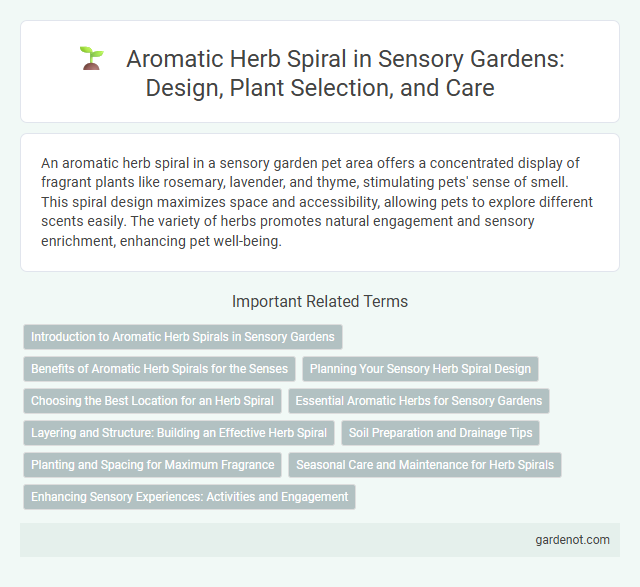An aromatic herb spiral in a sensory garden pet area offers a concentrated display of fragrant plants like rosemary, lavender, and thyme, stimulating pets' sense of smell. This spiral design maximizes space and accessibility, allowing pets to explore different scents easily. The variety of herbs promotes natural engagement and sensory enrichment, enhancing pet well-being.
Introduction to Aromatic Herb Spirals in Sensory Gardens
Aromatic herb spirals are a key design element in sensory gardens, combining vertical and horizontal planting to maximize space and sensory stimulation. These spirals feature a diverse array of fragrant herbs such as rosemary, thyme, and lavender, offering tactile and olfactory experiences that engage visitors. The varied microclimates created by the spiral structure support different herb species, enhancing biodiversity and educational opportunities.
Benefits of Aromatic Herb Spirals for the Senses
Aromatic herb spirals enhance sensory gardens by providing a compact, vertical structure that maximizes exposure to fragrant herbs like rosemary, thyme, and lavender, stimulating the olfactory senses. The diverse textures and colors of the herbs enrich tactile and visual experiences, promoting relaxation and mental well-being. This design also encourages biodiversity, attracting pollinators and supporting eco-friendly gardening.
Planning Your Sensory Herb Spiral Design
Designing a sensory herb spiral requires careful consideration of plant selection, sun exposure, and accessibility to maximize sensory stimulation and ease of maintenance. Arrange aromatic herbs like rosemary, thyme, and lavender in a spiraling pattern that ascends to create microclimates, optimizing varying moisture and sunlight levels. Incorporate tactile, fragrant, and visually appealing plants to enhance the garden's therapeutic and educational value.
Choosing the Best Location for an Herb Spiral
Selecting the best location for an aromatic herb spiral involves ensuring ample sunlight, ideally six to eight hours daily, to promote healthy plant growth. The site should have well-draining soil to prevent waterlogging and support diverse herb varieties such as rosemary, thyme, and basil. Positioning the spiral near outdoor seating or walkways maximizes sensory engagement and easy maintenance.
Essential Aromatic Herbs for Sensory Gardens
An aromatic herb spiral is a dynamic feature in sensory gardens, showcasing essential aromatic herbs like rosemary, lavender, thyme, and basil. These herbs release fragrant oils that stimulate the olfactory senses, promoting relaxation and mental clarity. Their varied textures and heights also enhance tactile and visual experiences, making the garden a multi-sensory oasis.
Layering and Structure: Building an Effective Herb Spiral
Creating an effective aromatic herb spiral relies on strategic layering and structure to maximize space and microclimates. Taller, sun-loving herbs like rosemary and thyme are placed at the top, while moisture-loving plants such as mint and chives occupy the lower, shaded areas near the spiral's base. This vertical design enhances water drainage and creates diverse growing conditions that support a rich variety of fragrant, sensory-stimulating herbs.
Soil Preparation and Drainage Tips
Preparing soil for an aromatic herb spiral requires well-draining, nutrient-rich loam combined with organic matter like compost to enhance fertility and moisture retention. Creating a raised spiral structure improves drainage by allowing water to flow naturally from the top to the bottom, preventing waterlogging around delicate herb roots. Incorporating coarse sand or grit into the soil mix further enhances aeration and drainage, essential for thriving Mediterranean herbs such as rosemary, thyme, and oregano.
Planting and Spacing for Maximum Fragrance
Plant aromatic herbs like rosemary, thyme, and lavender in a spiral design to create microclimates that enhance growth and fragrance concentration. Space plants closely, about 6 to 12 inches apart, allowing airflow while encouraging dense foliage development that intensifies essential oil production. This strategic planting maximizes aromatic output and sensory stimulation throughout the garden.
Seasonal Care and Maintenance for Herb Spirals
Seasonal care and maintenance for aromatic herb spirals involve regular pruning to encourage healthy growth and prevent overcrowding, particularly during spring and summer. Mulching with organic materials helps retain moisture and regulate soil temperature through changing seasons, ensuring optimal conditions. Monitoring for pests and diseases seasonally supports the vitality of herbs, promoting a thriving sensory garden year-round.
Enhancing Sensory Experiences: Activities and Engagement
An aromatic herb spiral enriches sensory gardens by offering a diverse range of fragrant herbs such as rosemary, thyme, and lavender, which stimulate olfactory senses and promote mindfulness. Interactive activities like herb harvesting, crushing leaves to release scents, and creating personalized herbal sachets engage visitors in hands-on, multisensory experiences. Incorporating educational signage about each herb's aroma and uses deepens understanding while encouraging exploration and connection with nature.
Aromatic herb spiral Infographic

 gardenot.com
gardenot.com